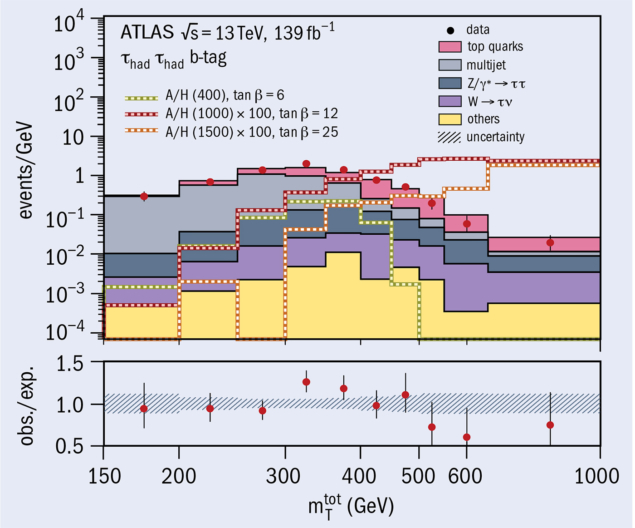A report from the ATLAS experiment

After the discovery of the long‑sought Higgs boson at a mass of 125 GeV, a major question in particle physics is whether the electroweak symmetry breaking sector is indeed as simple as the one implemented in the Standard Model (SM), or whether there are additional Higgs bosons. Additional Higgs bosons would occur, for example, in the presence of a second Higgs field, as realised in two‑Higgs doublet models, among which is the well‑known minimal supersymmetric extension of the SM (MSSM). The discovery of additional Higgs bosons could therefore be a gateway to new symmetries in nature.
ATLAS has recently released results of a search for heavy Higgs bosons decaying into a pair of tau leptons using the complete LHC Run 2 dataset (139 fb–1 of 13 TeV proton–proton data). The new analysis provides a considerable increase in sensitivity to MSSM scenarios compared to previous results.
The MSSM features five Higgs bosons
The MSSM features five Higgs bosons, among which, the observed Higgs boson can be the lightest one. The couplings of the heavy Higgs bosons to down‑type leptons and quarks, such as the tau lepton and bottom quark, are enhanced for large values of tan β – the ratio of the vacuum expectation values of the two Higgs doublets, and one of the key parameters of the model. The heavy neutral Higgs bosons A (CP odd) and H (CP even) are produced mainly via gluon–gluon interactions or in association with bottom quarks. Their branching fractions to tau leptons can reach sizeable values across a large part of the model‑parameter space, making this channel particularly sensitive to a wide range of MSSM scenarios.

New search
The new ATLAS search requires the presence of two oppositely charged tau‑lepton candidates, one of which is identified as a hadronic tau decay, and the other as either a hadronic or a leptonic decay. To profit from the enhancement of the production of signal events in association with bottom quarks at large tan β values (for example when the heavy Higgs boson is radiated by a b‑quark produced in the collision of two gluons), the data are further categorised based on the presence or absence of additional b‑jets. One of the challenges of the analysis is the misidentification of backgrounds with hadronic jets as tau candidates. These backgrounds are estimated from data by measuring the misidentification probabilities and applying them to events in control regions representative of the event selection. The final discriminant is on the quantity mTtot, which is built from the combination of the transverse masses of the two tau‑lepton decay products (figure 1).
The data agree with the prediction assuming no additional Higgs bosons, despite a small, non‑significant excess around a putative signal mass value of 400 GeV. The measurement places limits on the production cross section that can be translated into constraints on MSSM parameters. One realisation of the MSSM is the hMSSM scenario, in which the knowledge of the observed Higgs‑boson mass is used to reduce the number of parameters. The A/H → ττ exclusion limit dominates over large parts of the parameter space (figure 2), but still leaves room for possible discoveries at masses above the top‑anti‑top quark production threshold. ATLAS continues to refine this and conduct further searches for heavy Higgs bosons in various final states.
Further reading
ATLAS Collab. 2020 arXiv:2002.12223.
ATLAS Collab. 2020 ATL-PHYS-PUB-2020-006.





